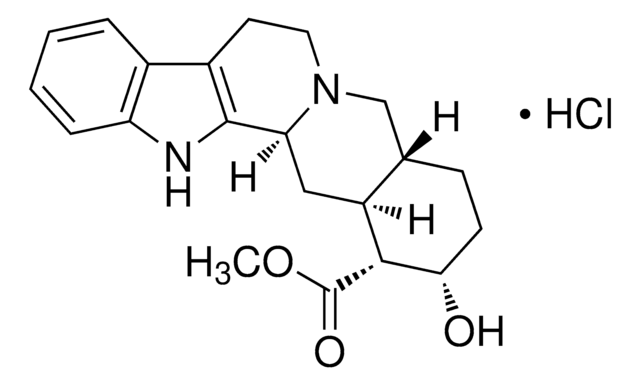Kluczowe dokumenty
P7791
Prazosin hydrochloride
≥99.0% (HPLC), powder, α1-adrenoceptor antagonist
Synonim(y):
1-(4-Amino-6,7-dimethoxy-2-quinazolinyl)-4-(2-furanylcarbonyl)piperazine hydrochloride, Furazosin hydrochloride
About This Item
Polecane produkty
Nazwa produktu
Prazosin hydrochloride, ≥99.0% (HPLC)
Poziom jakości
Próba
≥99.0% (HPLC)
Formularz
powder
rozpuszczalność
H2O: 0.5 mg/mL
methanol: 6 mg/mL
dilute aqueous acid: insoluble
ciąg SMILES
Cl.COc1cc2nc(nc(N)c2cc1OC)N3CCN(CC3)C(=O)c4ccco4
InChI
1S/C19H21N5O4.ClH/c1-26-15-10-12-13(11-16(15)27-2)21-19(22-17(12)20)24-7-5-23(6-8-24)18(25)14-4-3-9-28-14;/h3-4,9-11H,5-8H2,1-2H3,(H2,20,21,22);1H
Klucz InChI
WFXFYZULCQKPIP-UHFFFAOYSA-N
informacje o genach
human ... ADRA1A(148) , ADRA1B(147) , ADRA1D(146)
Szukasz podobnych produktów? Odwiedź Przewodnik dotyczący porównywania produktów
Opis ogólny
Zastosowanie
- to block the α1adrenergic receptors that mediate sympathetic vasoconstriction in mice
- as an α1-adrenoceptor blocker,administered intragastrically in rats
- as a vasodilator,administered together with inuslin into the left ventricle of mice for the assessment of its effects on renal functions
Działania biochem./fizjol.
Cechy i korzyści
Opakowanie
Przestroga
Hasło ostrzegawcze
Warning
Zwroty wskazujące rodzaj zagrożenia
Zwroty wskazujące środki ostrożności
Klasyfikacja zagrożeń
Repr. 2 - STOT RE 2 - STOT SE 3
Organy docelowe
Central nervous system
Kod klasy składowania
11 - Combustible Solids
Klasa zagrożenia wodnego (WGK)
WGK 3
Temperatura zapłonu (°F)
Not applicable
Temperatura zapłonu (°C)
Not applicable
Środki ochrony indywidualnej
dust mask type N95 (US), Eyeshields, Gloves
Wybierz jedną z najnowszych wersji:
Masz już ten produkt?
Dokumenty związane z niedawno zakupionymi produktami zostały zamieszczone w Bibliotece dokumentów.
Klienci oglądali również te produkty
Produkty
Gain a deeper understanding of the various types of receptor agonists and antagonists, including full, partial, and inverse agonists and competitive/reversible and non-competitive/irreversible antagonists.
Review alpha 1 adrenoceptors as well as their agonists, antagonists, and tissue expression patterns. We suggest several modulators and alternatives for working with a-1 adrenoreceptors.
Learn about alpha-2 adrenoceptor and its subtypes, mediated responses, and applications of agonists. Included is a list of available products and a comparison table.
Dowiedz się więcej o receptorze alfa-2 adrenergicznym i jego podtypach, pośredniczonych reakcjach i zastosowaniach agonistów. Zawiera listę dostępnych produktów i tabelę porównawczą.
Nasz zespół naukowców ma doświadczenie we wszystkich obszarach badań, w tym w naukach przyrodniczych, materiałoznawstwie, syntezie chemicznej, chromatografii, analityce i wielu innych dziedzinach.
Skontaktuj się z zespołem ds. pomocy technicznej















